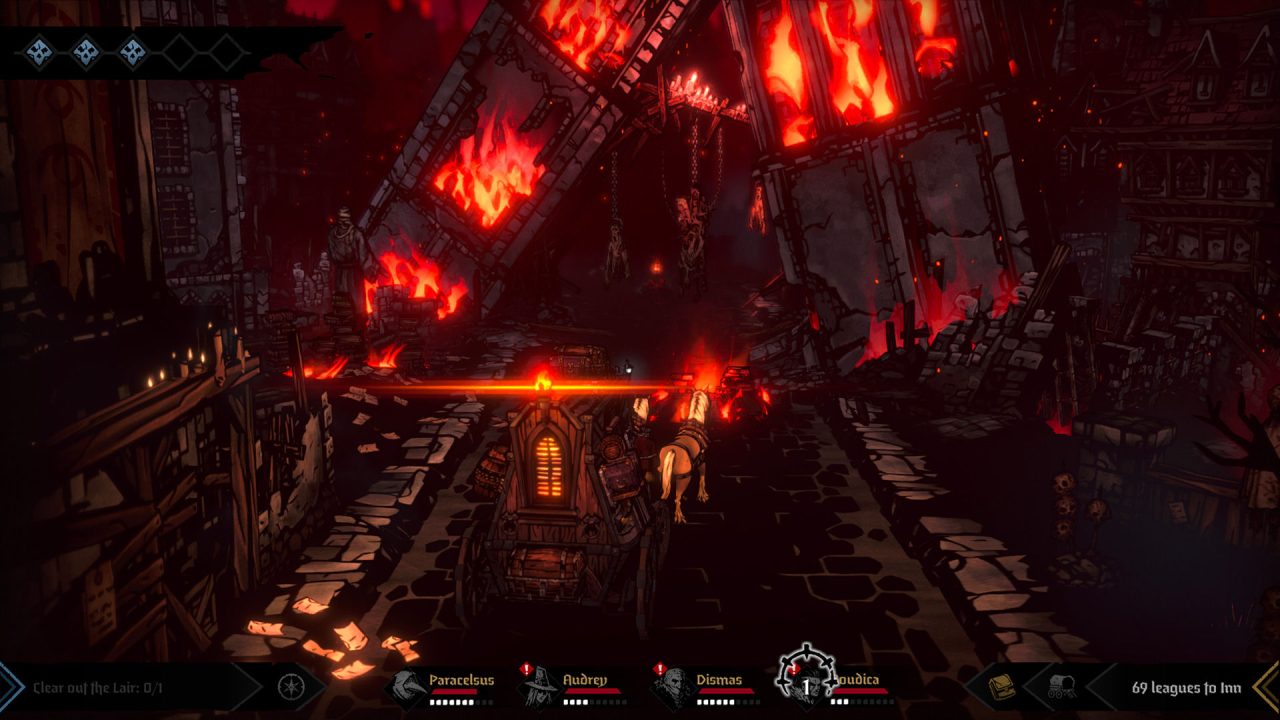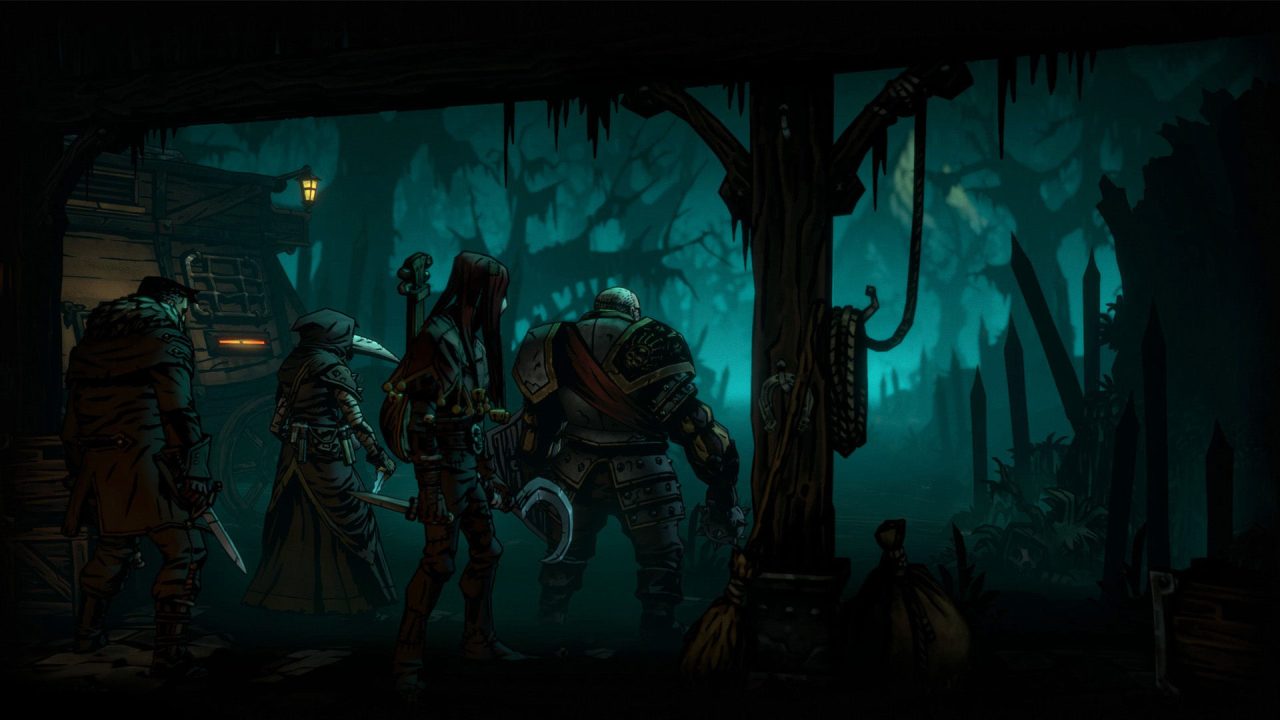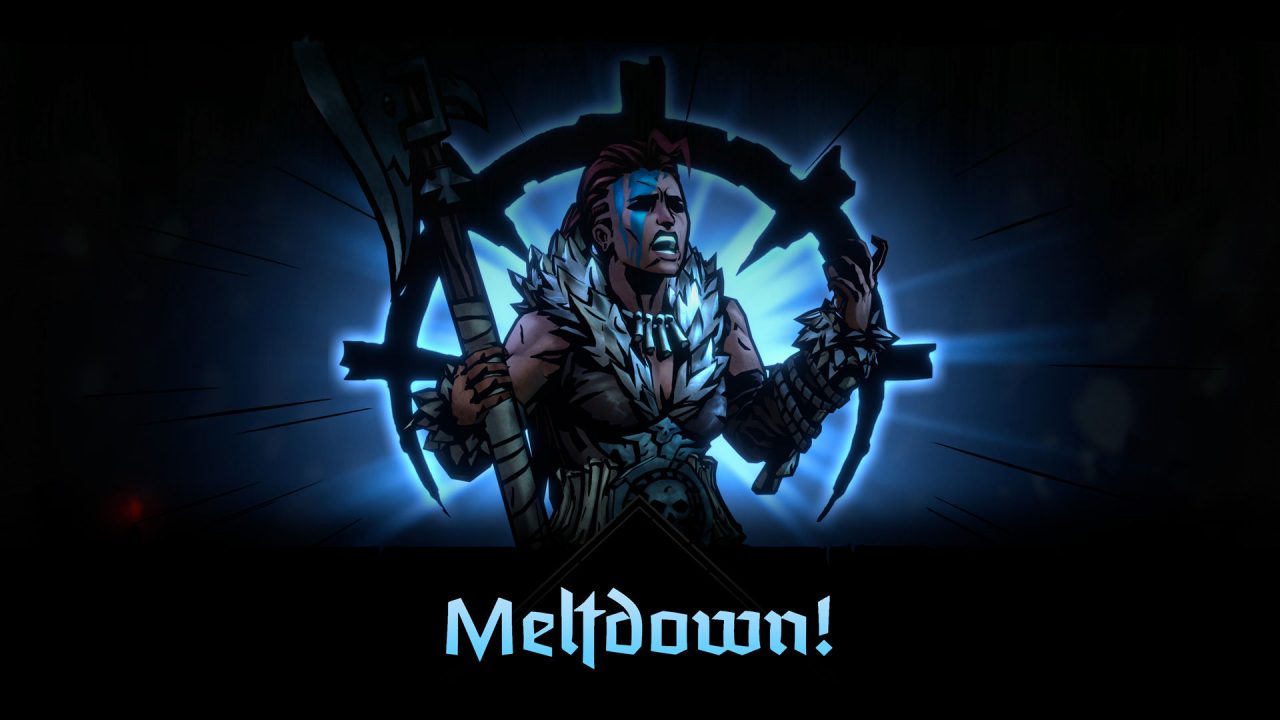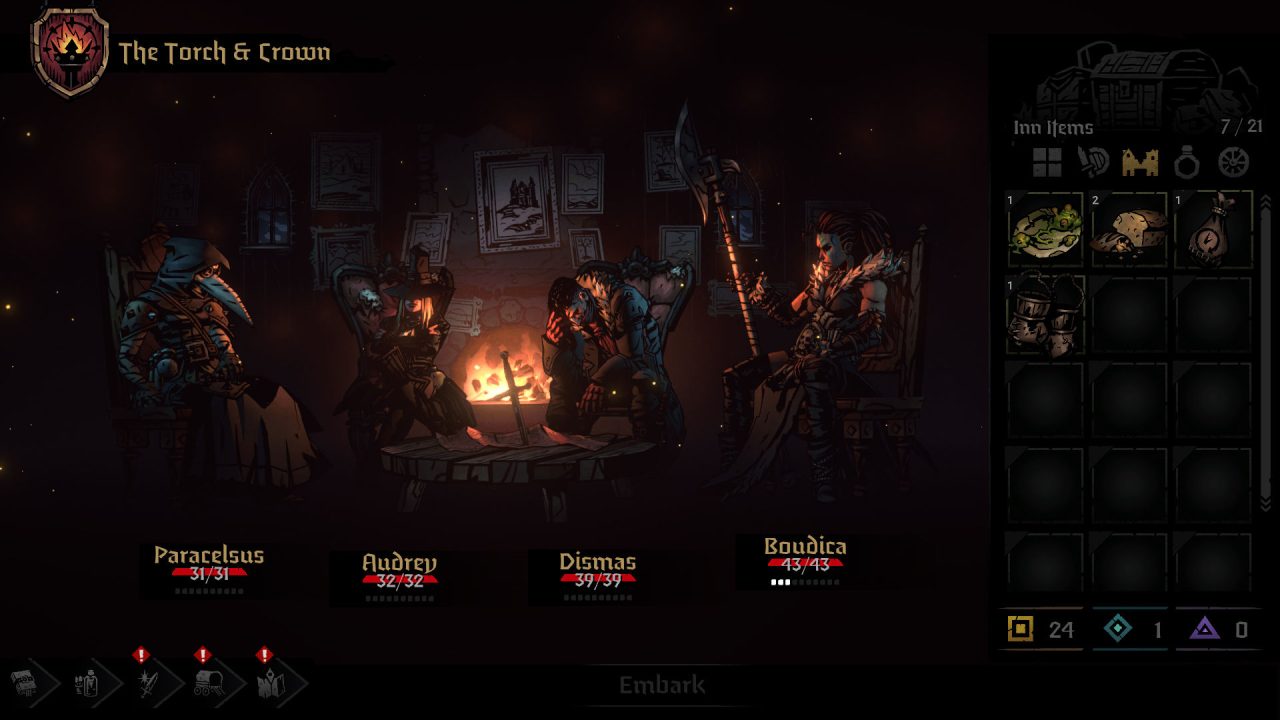“Oh, come on!” I shout at my computer monitor as my plague doctor goes through her second meltdown. My grave robber is dead, the highwayman and hellion are barely hanging on, and the boss is just overwhelming my team. I’d love to say this was an uncommon occurrence in Darkest Dungeon II but my time with the game was primarily going through an entire run only to get slaughtered by the boss. My team dies; I push my office chair back and storm out of the room. I throw the leash on my dog and we hit the street to get a nice morning walk in. I put a podcast on but I’m not really listening: I’m thinking about what I could have done differently. Before I know it, I’m back home and starting up another run. I’m ready to get angry again.
While downloading and getting ready to start Darkest Dungeon II for the first time, I reflected on what I felt wasn’t enjoyable about Darkest Dungeon 1. It’s been over seven years since Darkest Dungeon went into Steam’s Early Access program in 2016, and a lot has changed since then. Primarily, the roguelike genre, which had seen such a huge surge and major success in the 2010s, is more refined. Thus the caliber of game required for success has a higher bar. Darkest Dungeon 1 is absolutely one of the best in the genre, but it’d be a far stretch to say that it was a perfect game. Expeditions were too short, and even the long ones had a rest or two before hitting the boss or completing a tedious dungeon exploration and heading back to rest your team. You’d then send out the secondary or backup team to handle an easier expedition or two while the primary team rested. And dungeons were boring, being mostly littered with curios intended to keep your inventory space down and battles.

Darkest Dungeon II comes in and throws a spin on the whole formula. You have your hamlet, now known as the Altar of Hope, but it’s a place to unlock permanent upgrades, trinkets, customized palates for your characters, or even the characters themselves. Beyond that, there’s little management. Your primary avatar is a rickety stagecoach with a small torch on top. I was glad they kept the torch as a mechanic in the game. The narrator is still there, making deep, gravelly observations. From the Altar of Hope, the stagecoach rolls onto the confessional. Picking a confession determines which chapter of the game you’ll play, and the narrator will explain the certain doom your team will face. Finally, there’s The Crossroads, where you’ll choose your team. I immediately noticed the roster was not as full as the first game. Disappointed at some of my favorite heroes missing, I slowly rolled into the first area.
Entering combat for the first time, I was now in familiar territory. I completed the turn-based battle with gusto and collected my rewards, relics, and baubles — nothing too exciting yet. If you’re unfamiliar, Darkest Dungeon’s battles are a turn-based affair with the turn order determined by a speed stat. Placement in Darkest Dungeon II is important, determining skills that the character can use and who, in the line-up, they’re able to use those skills against. As the stagecoach barreled further down the cobblestone road, I reached the very first inn and the game started to make a little more sense. Greeted with mastery points, I started looking at the options before me, skills to be upgraded. This early into my run, I was greeted with options to upgrade basic skills or even utility skills to make the run that much smoother. The wainwright allowed me to attach items to my stagecoach for a chance to produce a medicinal item at every event stop or increase the chances of having a positive relationship point while in the stagecoach. I could attach special torchlights to the stagecoach as well, making my journey easier or harder depending on the torch equipped. Be warned though, the game says: once you attach a torch, it cannot be removed or replaced until the run is over.
Finally the changes Red Hook Studios had made to the Darkest Dungeon formula began to make sense and click with me. Darkest Dungeon 1 was all about permanent change. While Darkest Dungeon II does not abandon the idea of permanent change, it also allows you to make more ephemeral changes, changes specific to a single run. I used mastery points, for example, to upgrade an established skill order based on how important I felt each skill could become. Trinkets are unlocked between runs but you’re unable to sell them during the run, making them temporary as well. The upgrades applied to my stagecoach were limited to what I found on the road or at an inn, or whether I came across The Hoarder, a merchant on this damned journey. Once the run was over, those items didn’t return to me; I had to find them yet again. The ability to come across these items and upgrades was permanent, but holding them was fleeting.

I rolled through the first act and was immediately surprised by the number of stops before me. In the bottom right, I was told how many leagues I had until my next rest. On the branching path before me, there were seven separate stops with further branching paths, each one a step closer to determining my team’s fate. When choosing a path, I had multiple considerations to make. Will this path ultimately lead me to where I wish to go? Can I withstand another attack on the stagecoach? Do I think The Hoarder will have any actual upgrades or should I try to get through as many stops without combat as possible? If I was lucky, there would be a watchtower as one of the first stops, allowing me to plot my journey but often, I was running blind. Stress built, not just between party members, but in me as well.
Will the party manage to get along throughout this trip or will it end up as a disastrous crescendo of animosity in the face of danger? I can assure you; it almost always ends up in a disastrous crescendo of animosity. But when it didn’t, I felt invincible. Relationships are tenuous in the best circumstances so it’s understandable that they would devolve quickly during the stagecoach ride. When you roll up to events, your heroes will have an opinion on how that event should be handled. That opinion can have a positive or negative effect on their relationship with another hero. Whether a relationship blossoms or withers is not always up to you but is significantly influenced by your actions, and the results can be powerful. When a relationship forms, you are informed before embarking from the inn. Both positive and negative relationships affect skills used in battle. In a negative relationship, one character’s use of skills can negatively affect the other player. For example, if my plague doctor and hellion have a negative relationship, the plague doctor’s blinding gas may now cause the hellion to deal less damage the turn after blinding gas is used. Conversely, a positive relationship may have resulted in blinding gas giving a small heal or a buff to the hellion. These relationships determine the fate of your party.
Part of the struggle of getting along is making sure the stagecoach is in tip-top shape. Your basic, unequipped stagecoach can withstand three hazards that attack the armor or three rough roads that hurt your wheels. If you run out, prepare for a battle. This special battle requires at least one member of the team, per round, to forfeit their turn and spend it repairing the stagecoach. Regardless of how long the battle itself takes, one member must always be on repair duty. Another hazard to watch out for while on this cursed journey is oblivion tears. These tears create loathing, a general evil that’s beset the world, and the more there is, the tougher the journey becomes. Loathing can be reduced by fighting battles, but if maxed out, the confession boss at the end of your run will stir and that battle will be more difficult.

Loathing, relationships… surely there’s no third prong to make this Bident of Brutality a Trident of Terror? Stress comes over from the first game, and is largely the same. Each character has a stress bar below their health bar and some characters have stress-healing abilities. Some enemies can even block stress healing, which is quite frustrating. When the stress bar fills up, you’re in for trouble. The party member that stresses out will have a meltdown, which removes all of their stress. But with losing stress comes losing health. In fact, the party member in meltdown loses most of their health, as well as affinity (relationship points) with all party members. There is a very small chance of the party member becoming resolute, which causes them to heal, gain several buffs, and raise affinity with their party members. Don’t hold your breath though. In over forty runs, fewer than five times did anyone become resolute when stress hit max. And stress hit max a lot.
Narratively, Darkest Dungeon II expands on our heroes through the Shrines of Reflection. Upon reaching them, you’ll choose a hero whose story you’d like to explore. This excited me because although you learn a bit about the heroes in the first game, Darkest Dungeon II provides five chapters for each hero. More importantly, it’s not always just the narrator explaining the backstory of the hero. In the Plague Doctor’s story, I got to control her in a battle of wits against her professor. In the case of the Grave Robber, against her drunk and abusive husband. These were not only sweet reprieves from the cursed adventure I was on but an insightful look at why these heroes began their odyssey. And I couldn’t help myself: if I saw a Shrine of Reflection on the map, that was my target. I wanted to learn the backstory of every accursed hero in my roster.
Darkest Dungeon II’s aesthetic remains unchanged from the first game. Artistically, Darkest Dungeon II boasts a unique art style so iconic that it’s the first thing I think of when someone mentions the game. Harsh outlines, beautifully contrasted colors, and a simple but informative UI: like its predecessor, Darkest Dungeon II sets an artistic bar for games of its ilk. I have a particular love for the stagecoach, the narrow ramshackle vehicle, speeding down the highway to certain doom, a lone torch at the top with a flickering flame slowly dwindling to nothing as the adventure goes on. Though I love the stagecoach, perhaps Darkest Dungeon II’s best offering is the slumped-over and exhausted party members when you finally reach the inn. Each character’s personality truly shines when they’ve exhaustively thrown themselves into a chair around the hearth of the inn.

If you’ll recall, my evaluation of Darkest Dungeon II was contingent on whether I felt it resolved some of the issues from the first game. I wanted to know, is Darkest Dungeon II really necessary? The answer is yes. Darkest Dungeon 2 isn’t a perfect game by any means, and as someone who isn’t a fan of difficult games or games that I feel intentionally aim to cause me grief, I cannot say I wasn’t annoyed or even lashed out at the game. But the design behind Darkest Dungeon II, the care put into exploring this world, telling this tale, and making a game that you’d want to play repeatedly is absolutely brilliant. As it was the first time around. Iteratively, Darkest Dungeon II is a must-play for anyone who found anything enjoyable about the first game. Newcomers be warned: Darkest Dungeon II is an incredible experience.


